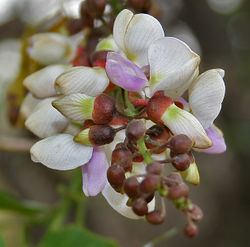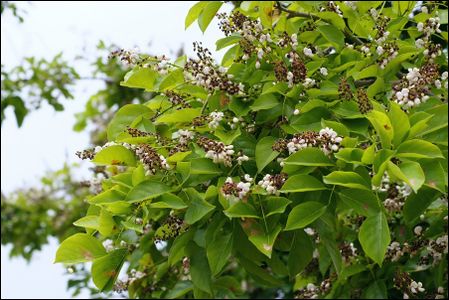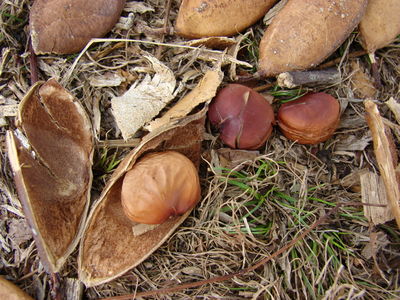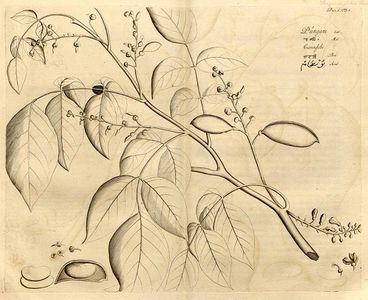Millettia pinnata
(L.) Panigrahi
| Ordre | Fabales |
|---|---|
| Famille | Fabaceae |
| Genre | Millettia |
2n =
Origine : Asie tropicale
sauvage et cultivé
| Français | |
|---|---|
| Anglais |
- médicinal
- poison de pêche
- feuilles insectifuges
- huile des graines : usages industriels
- fourrage : feuilles, tourteau de graines
- engrais vert
- ornemental
- arbre d'alignement
- arbre d'ombrage (plantations de thé)
- ramilles : brosse à dents
- mellifère
- écorce : cordes
Description
Noms populaires
| français | arbre de pongolote |
| anglais | pongam, Indian beech ; pongame oil tree (Am) ; seashore mempari (Singapour) |
| sanscrit | karañjah (Wealth of India) ; करञ्ज - karañja, नक्तमाला - naktamala |
| hindi | karañj, karañja (Wealth of India) ; करंज - karanja |
| bengali | karanj, karanja (Wealth of India) ; করঞ্জ - karanja |
| marathi | karanj, karanja (Wealth of India) |
| gujerati | karanj, karanja (Wealth of India) |
| konkani | करंजी - karamji |
| telugu | gaanuga, pungu (Wealth of India) ; కానుగు - kanugu |
| tamoul | pongam, ponga (Wealth of India) ; புன்கு - punku, புன்னை - punnai |
| kannada | honge (Wealth of India) ; ಹೊಮ್ಗೆ - homge |
| malayalam | pungu, punnu (Wealth of India) |
| oriya | koranjo (Wealth of India) |
| Punjab | sukhchein, karanj, paphri (Wealth of India) |
| Assam | karchaw (Wealth of India) |
| Philippines | bani (général), balikbalik, balok (tagalog) (PROSEA) |
| Indonésie | bangkong (javanais), ki pahang laut (sundanais), kranji (madurais) (PROSEA) |
| Malaysia | mempari, kacang kayu laut (péninsule), biansu (Sarawak) (PROSEA) |
| Thaïlande | khayi, yi-nam (péninsule) (PROSEA) |
| Vietnam | dây mấu, dây lim, khổ sâm hoa (PROSEA) |
| Laos | (do:k) ko:m ko:y (PROSEA) |
- Voir l'étymologie de Pongamia
Classification
Millettia pinnata (L.) Panigrahi (1989)
basionyme :
- Cytisus pinnatus L. (1753)
synonymes :
- Pongamia pinnata (L.) Pierre (1899)
- Robinia mitis L. (1763)
- Derris indica (Lam.) Bennet (1971)
- Pongamia glabra Vent. (1803)
Cultivars
Histoire
Usages
In India widely cultivated as road tree, also used for afforestation and for several by-products. In Sri Lanka and E Africa grown as shade tree for tea plantations. The species is a typical multipurpose tree, in S India leafy twigs are used as fodder and for green manuring (rice and sugarcane fields, coffee plantations), almost all parts of the plant are highly esteemed in the folk medicine, the seed oil is technically used for various purposes, e.g. impregnation of leather wares, also pharmaceutically and as lubricant. In the Indian folk medicine the species has a very old tradition. Recently the establishment of plantations of the tree for the production of the seed oil is strongly recommended.
Références
- Rollet, Bernard et coll., 2010. Arbres des Petites Antilles. Tome 1 : Introduction à la dendrologie. 276 p. Tome 2 : Description des espèces. 866 p. + 46 pl. coul. + CD de photos sur l'anatomie du bois. Basse-Terre, ONF. Voir sur Pl@ntUse.







